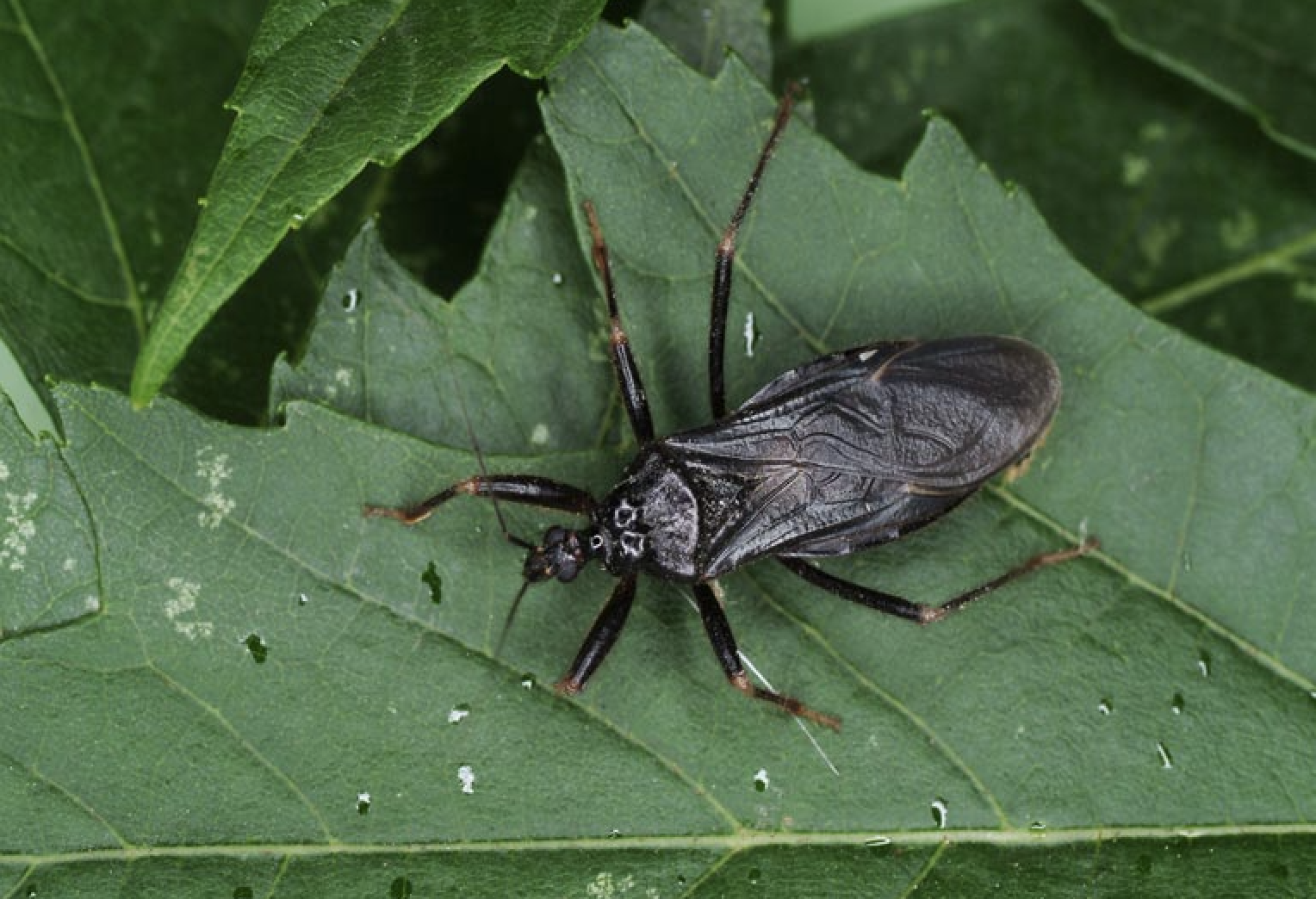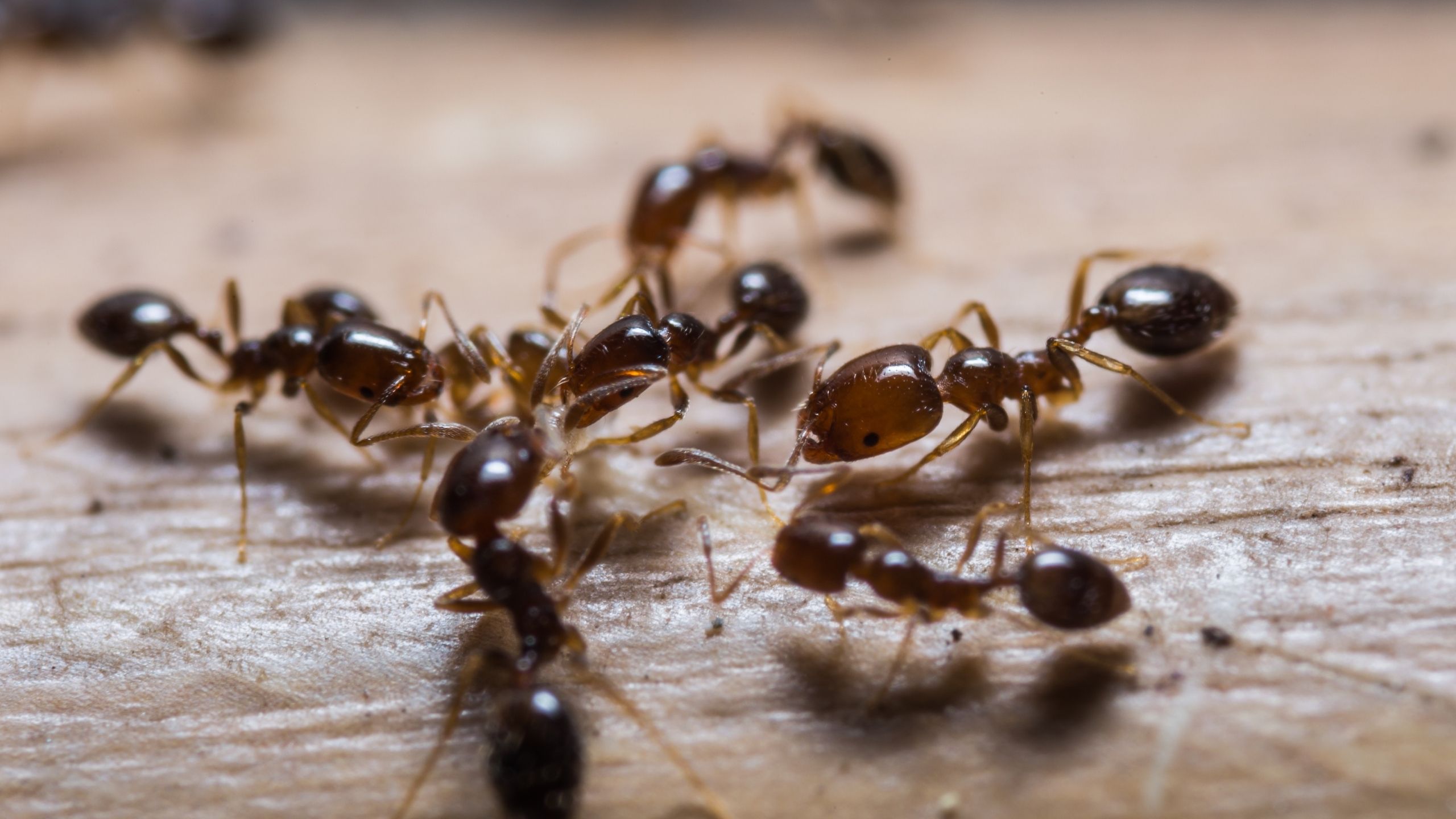Western Conenose Bug (Kissing Bug)
January 2021
Zachary Schumm, Arthropod Diagnostician (No longer at USU)

Fig. 1. Western conenose bug (Triatoma protracta) adult. Arrow: the abdominal margin that can be lighter in color. Adults measure between 0.5 and 0.9 inches long.
 Fig. 2. Conenose bug nymph. Note the small wing “buds” on the upper back. Nymphs measure between 0.1 and 0.5 inches long.
Fig. 2. Conenose bug nymph. Note the small wing “buds” on the upper back. Nymphs measure between 0.1 and 0.5 inches long. Fig. 3. Masked hunter, a conenose bug look-alike. It does not vector human parasites.
Fig. 3. Masked hunter, a conenose bug look-alike. It does not vector human parasites.
Fig. 4. Western conifer seed bug, a conenose bug look-alike that is common in residential areas.

Fig. 5. Squash bug, a conenose bug look-alike that is common in residential areas and gardens.
What You Should Know
- Kissing bugs are a type of true bug, in the assassin bug family, that feeds on the blood of vertebrates.
- The only species of kissing bug known to occur in Utah is the western conenose bug (Triatoma protracta), and it is not commonly found.
- While western conenose bug can carry the parasite that causes Chagas disease of humans, transmission is not likely to occur; the parasite is not transmitted from bites.
- Bites from a kissing bug can cause localized redness or swelling, which usually subsides without treatment. Allergic reactions are uncommon.
- Prevention of kissing bugs in the home is best achieved by sealing up gaps in window and door frames and reducing night lighting that attracts the bugs.
Kissing bugs are a member of the insect order Hemiptera (the true bugs). Like all true bugs (which includes squash bugs, stink bugs, aphids, boxelder bugs, and others), the kissing bug has a piercing-sucking mouthpart that is used for feeding. Specifically, kissing bugs are a type of assassin bug in the insect family Reduviidae, which are considered beneficial because they are predatory and feed on other insects that could be considered pests. However, some assassin bugs, specifically those in the subfamily Triatominae (“kissing bugs”), feed on the blood of vertebrates and some are known vectors of the parasite that causes Chagas disease. Kissing bugs are the only insects known to transmit this parasite.
Chagas disease is caused by the parasite Trypanosoma cruzi. Kissing bugs vector the parasite. There is a common misconception that the parasite can be transmitted from a kissing bug bite, but this is not the case. Instead, it exists in the insect’s feces. Humans can become infected when infected feces comes into contact with a mucous membrane (eyes, mouth, nose, etc.) or a break in the skin. Thus, if a kissing bug that is carrying the parasite bites a human and defecates near the bite, subsequent scratching of the bite or touching of a mucous membrane after contacting the infected feces could result in infection. Other methods of transmission such as congenital (from an infected pregnant mother to child) and via blood transfusion using blood from an infected individual are possible but uncommon.
Eleven species of kissing bugs are known to occur in the United States, all of which feed on the blood of vertebrates (CDC, 2020). The western conenose bug, Triatoma protracta, is the only species of kissing bug known to occur in Utah. Seven additional species of kissing bugs are known to occur in the Southwest and Mountain West regions of the U.S.: Paratriatoma hirsuta, Triatoma gerstaeckeri, T. incrassata, T. indictiva, T. lecticularia, T. recurva, and T. rubida. To view photos and geographic range of other species, visit the CDC webpage on kissing bugs. The life cycle and prevention of kissing bugs is similar regardless of species.
Description and Life Cycle
Western conenose bug is a large insect (0.5 – 0.9 inches long), solid black to dark brown, and has wings that often do not completely cover the abdomen (Fig. 1). Sometimes, the lateral margins of the abdomen can be a lighter color than the rest of the insect. They also possess a head that is extremely elongated and pointed. Nymphs resemble adults but are smaller (0.1 – 0.5 inches) and do not have fully formed wings (Fig. 2).
The entire life cycle of western conenose bug in Utah is not fully known. Adults will generally lay eggs in the late summer in crevices and protected areas in human and natural structures. Newly hatched nymphs will need to feed on blood (primarily from rodents) so they can molt into the next subsequent nymphal stage; there are five nymphal stages before reaching adulthood. Fifth instar nymphs (the last stage before adulthood) will overwinter inside protected structures. In spring, the nymphs will molt into adults and continue the cycle.
Risks of Kissing Bugs in Utah
Western conenose bug is not expected to transmit Chagas disease as easily as other kissing bug species. This is because it is known to defecate away from its host, as opposed to other species that defecate on their host as they feed (Cranshaw, 2020). It is also not a common insect in Utah and primarily feeds on other vertebrates. Therefore, the risk of Chagas disease transmission from the feces of western conenose bug is extremely low. There are no known cases of Chagas disease transmission from western conenose bug in Utah.
Symptoms of Bites and Disease
Bites from kissing bugs are often painless but can cause symptoms such as redness, swelling, hives, and (rarely) anaphylactic shock, similar to other insect bites or stings. As with a bite or sting from any insect, seek medical attention if you experience any signs of an allergic reaction, or for more mild symptoms that do not diminish on their own.
Note that Chagas disease infection can be symptomless or life-threatening and the symptoms can match several other illnesses and diseases. Short-term symptoms that last for a few weeks after infection can include fever, aches, diarrhea, and vomiting. Chronic complications can last for years or be lifelong, including both cardiac and gastrointestinal complications (CDC, 2020).
If You Are Bitten
Look-Alikes
The most common look-alike insect that is submitted to the UPPDL as a possible kissing bug is the masked hunter (Fig. 3). This is a similar-looking bug that is entirely black in color and mimics the size of a kissing bug (~0.5 inches long). However, the masked hunter is not as robust, and the wings usually cover the tip of the abdomen. In addition, the head of a masked hunter is shorter and less pointed than the head of a kissing bug. Masked hunters are of no health concern to humans, although they can inflict a painful bite if threatened.
Other insects that superficially resemble a western conenose bug’s size and shape include conifer seed bug (Fig. 4) and squash bug (Fig. 5). However, these insects are not solid black, but rather gray-brown and often have a pattern or mottled (speckled) appearance covering their bodies.
If you see an insect that resembles a kissing bug, acquire a quality photo of the specimen and send it to the UPPDL for confirmation. If needed, store the specimen in a container in a freezer.
Prevention
Under normal circumstances, western conenose bug is not common in well-developed areas with human structures. However, nymphs will look for shelter in late fall (which includes human structures) and are attracted to lights at night. To limit these bugs from entering your home, reduce light outside the home, and re-seal gaps in windows, door frames, and thresholds that have small gaps. You can replace exterior light bulbs with sodium vapor bulbs, which are generally less attractive to insects. These exclusion and deterrence methods will also help to prevent other nuisance pests from entering the home.
References
- Centers for Disease Control and Prevention (CDC)(2020). Triatomine bug FAQs. U.S. Department of Health and Human Services.
- Cranshaw, W. S. (2020). Conenose bugs ("kissing bugs") and insects of similar appearance in Colorado [Fact Sheet]. Colorado State University Extension.
Image Credits
1 Zach Schumm, Utah State University Extension
2 Daniel Horner, Bugguide.net. License
3 Joseph Berger, Bugwood.org
4 Gyorgy Csoka, Hungary Forestry Research, Bugwood.org
5 Whitney Cranshaw, Colorado State University, Bugwood.org
Related Research








